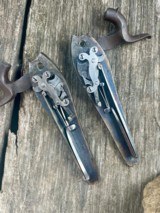 |
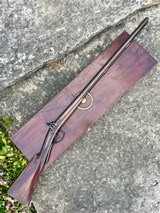 |
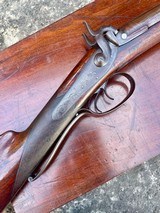 |
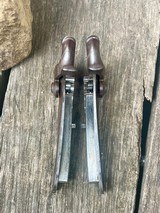 |
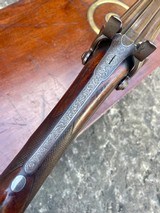 |
 |
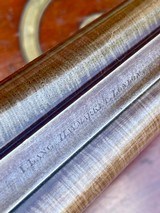 |
 |
 |
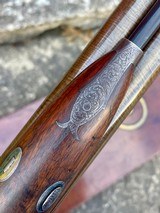 |
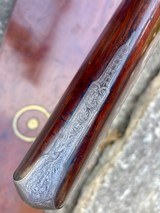 |
 |
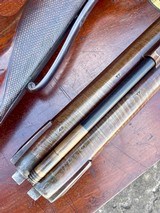 |
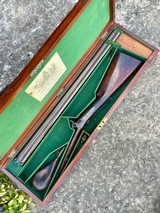 |

EARLY 1820S 14 BORE DOUBLE PERCUSSION BACK ACTION LOCK SPORTING GUN BY JOSEPH LANG
Guns International #: 102652633 Seller's Inventory #:
Category: Antique Shotguns - Percussion - Lang, Joseph Shotguns
Seller's Information
When emailing or calling sellers direct, please mention that you saw their listing on GunsInternational.com
Seller: R.A. Butler
Member Since: 2/25/18
First Name: Richard
Last Name: Butler
State: Indiana
Zip: 47025
Country: United States
Phone: (812) 537-9820
Number of Active Listings: 1
Total Number of Listings: 13
Seller: Private Seller
Return Policy: 3 day inspection and return policy on used guns.
Payment Types Accepted:
Description:
This early 1820s double percussion 14 bore back action lock sporting gun by the venerable Joseph Lang is a more historic, interesting, and high quality gun than it may appear at first glance, the gun having obviously browned over the two centuries since it left Lang's shop. Although the gun has browned, it has not been abused or otherwise neglected. It is a solid and serviceable gun without any exceptions.
This gun is serial number 104 and is possibly the lowest serial number Joseph Lang gun extant. If you are aware of an earlier Lang I'd be delighted to hear of it. Lang set up on his own in 1821. He previously worked for Alexander Wilson of 1 Vigo La. and then 14 Titchbourne St., Picadilly. As of 1825 Lang is recorded as "Joseph Lang Gun and Pistol Repository (from Wilson's Warehouse, Vigo La.) at 7 Haymarket." Brown, Nigel, London Gunmakers, p. 61 (1998). The top rib of this gun near the breach is marked "I. LANG, HAYMARKET, LONDON." Brown explains the surviving Lang serial number records begin in 1858, long after this gun was made. There is, however, mention of serial number 979, a percussion double rifle, in the later records, no doubt entered because the gun came back to Lang for repair. Lang moved to 22 Cockspur Street, Charring Cross in 1853.
Attesting to this gun's high quality are the beautiful 28 3/8" flint style straight sided tube damascus 14 bore barrels made by one of the best barrel makers of the period, Thomas Fullerd as evidenced by the "TF" marking under each tube. Thomas was the brother of William Fullerd, also a top notch barrel maker.
Further attesting to the quality of this early Lang gun are the extraordinary back action locks. Although some may frown at back action locks they are of no less quality than a good front action lock and typically result in a more graceful looking gun through the wrist and breach to my eye. I am providing some extra photos of the locks so you can see the extraordinary skill of the lock maker. These convex lock plates as well as the mainsprings are curved through their entire length, both of which features add to the graceful look I mentioned earlier. Internally, the locks are exquisite and in their original high polish condition. Of course, they function flawlessly and the strong mainsprings do exactly what they're supposed to do, i.e., positively detonate the percussion cap and prevent any blowback.
Additional details worthy of note contributing to this guns high quality are the extra long tang of the standing breech, the most delicate little vacant silver wrist escutecheon I think I've ever seen, the fine engraving, and the wood to metal fit, the wood still today looking like it's grown around the iron. The gun also includes a grip safety, a practical feature for an upland bird hunting gun.
Lang was always a significant figure in the London gun trade. In 1826, he ended up with Joseph Manton's stock upon Joseph's bankruptcy, no doubt a bit of a coup at the time. Lang opened one of the earliest recorded shooting gallery and school in 1827. Brown includes an image of the indoor range at page 62 of his London Gunmakers. I can't help but wonder what it must have been like inside that indoor range once a handfull of shots of black powder were fired. Lang married one of James Purdey's daughter's making James the younger his brother-in-law. He also sold a large inventory of James Purdey's for some reason between 1830 and 1834, a testament to his relationship with Purdey.
Most importantly, it was Jospeh Lang who took the early breech loading mechanism of Lefaucheux displayed at the Great Exhibition and "developed that principle and allied it to the highest standards of production." Brown, Nigel, London Gunmakers, p. 11 (1998). Thus, Lang figured prominently in the continuation of the London gunmakers' world-wide reputation for the quality and reliability of their sporting arms. The Manton's got London gunmakers there but it was the likes of Lang and others that continued and propelled that tradition. As Nigel Brown explains, "Just before leaving his Haymarket premises, he exhibited at the Great Exhibition and was very impressed with a French Lefaucheux gun, so much so that in 1856 he introduced his own version using the Houillier pin-fire cartridge system. His marketing of this design and subsequent improvements to it have resulted in Lang's name being forever linked to the introduciton of breech loading sporiting firearms into Great Britain." Brown, Nigel, London Gunmakers, p. 61 (1998).
The gun comes in an original Lang case but of a later vintage than the gun. The original trade label in fine condition has Lang's later 22 Cockspur address. The case has been modified to fit this gun nicely.
An historic, interesting, and high quality early 1820s double percussion 14 bore back action lock sporting gun by one of London's greatest makers, possibly his earliest work extant, and a bargain at $2,900. You couldn't have one of these extraordinary locks made for that money today.
Price: $2,900.00